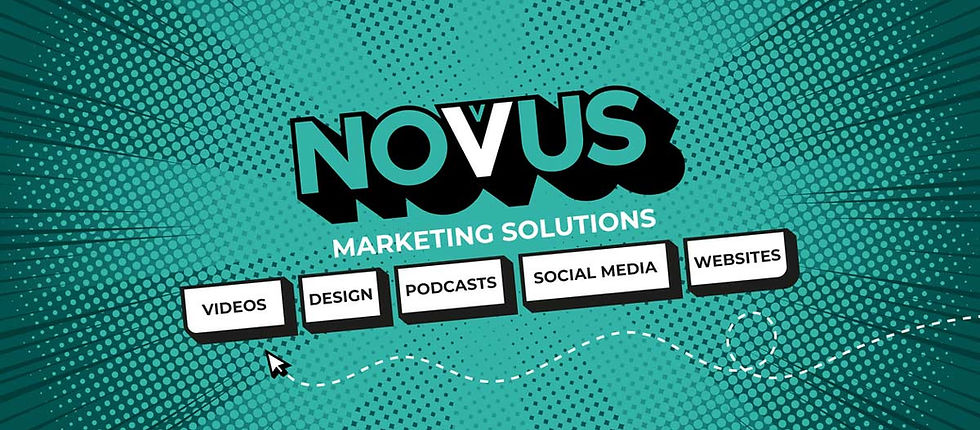Why Rebranding is Good but Can Be Difficult
- Novus
- May 15, 2024
- 4 min read

At Novus Marketing Solutions, we are in the midst of an exciting transformation. Our old logos and marketing materials, while once cutting-edge, are now several years old and in need of a refresh. As we strive to stay current with new trends and technological advancements, we recognize the importance of evolving our brand to better reflect who we are today and where we’re headed. This journey is not just about a new look; it’s about embracing change and positioning ourselves for continued success in a dynamic market.
The Importance of Rebranding for Businesses
Rebranding is not just for new or struggling companies; even established and successful businesses need to refresh their brands regularly. This need stems from several factors:
Staying Relevant: As market trends and consumer preferences change, brands must adapt to stay relevant. What worked a few years ago might not resonate today.
Reflecting Growth: Companies evolve, and their branding should reflect their current identity, values, and mission.
Technological Advancements: New technologies and platforms require brands to update their visuals and messaging to ensure they are optimized for various devices and media.
Some businesses choose to overhaul everything during a rebrand, while others prefer incremental changes. Coca-Cola is a prime example of a brand that has successfully maintained its core identity while making subtle updates over time. Their logo has undergone minor tweaks to modernize its appearance without losing the classic elements that make it instantly recognizable.
Successful Rebranding Examples
Apple (1997): When Steve Jobs returned to Apple, he led a significant rebranding effort that included updating the company's logo. The transition from the colourful, striped apple to a sleek, monochromatic version symbolized a new era of innovation and sophistication. This change helped reposition Apple as a leader in the tech industry and contributed to its resurgence.
Starbucks (2011): Starbucks simplified its logo by removing the word "Starbucks" and the word "Coffee," focusing solely on the iconic siren. This update reflected the brand's expansion beyond coffee into a broader lifestyle brand. The minimalist design reinforced Starbucks' global recognition and adaptability.
Google (2015): Google updated its logo to a modern, sans-serif typeface that was more versatile and mobile-friendly. This change represented Google's evolution and its emphasis on digital and mobile platforms. The updated logo maintained the brand's playful and approachable image while enhancing its digital presence.
When Rebranding Misses the Mark
Rebranding can be risky, and sometimes it misses the mark entirely. This often happens when corporate leaders, disconnected from the brand's core identity, attempt to emulate the success of others without considering their own brand's unique attributes.
Tropicana (2009): Tropicana's redesign replaced the iconic orange and straw image with a glass of orange juice, significantly altering the logo. Consumers did not respond well to the new packaging, resulting in a 20% drop in sales within two months. Tropicana quickly reverted to the original design, highlighting the importance of understanding consumer attachment to brand elements.
Gap (2010): Gap introduced a new logo that replaced its long-standing blue box with a minimalist design. The backlash from consumers and design critics was swift and severe, leading Gap to revert to its original logo within a week. This incident underscores the risks of drastic changes without thorough consumer research and engagement.
Pepsi (2008): Pepsi's rebranding included a new logo and packaging design, which significantly altered the iconic globe symbol and typeface. The redesign was costly and failed to resonate with consumers, leading to confusion and criticism. While Pepsi did not revert to the old design, the update did not achieve the desired impact and required further adjustments.
Key Takeaways for Brand Updates
Consumer Research: Understanding consumer preferences and attachment to current brand elements is crucial. Tropicana and Gap's failures highlight the importance of this step. Engaging with consumers through surveys, focus groups, and feedback can provide valuable insights.
Gradual Evolution vs. Radical Change: Brands like Apple and Google succeeded by making thoughtful, evolutionary changes rather than radical overhauls. This approach can help maintain brand continuity while modernizing its appearance.
Clear Communication: Effective communication about the reasons and vision behind a rebrand can help consumers understand and embrace the changes. Starbucks’ successful rebrand was partly due to clear messaging about its broader vision.
Flexibility and Adaptability: Successful updates often involve designs that adapt well to various platforms and media, as seen with Google's logo update. Ensuring the new brand elements are versatile and scalable is essential in today's digital landscape.
Internal and External Buy-In: Engaging both employees and consumers in the rebranding process can foster acceptance and enthusiasm. A rebrand should reflect the company's values and culture, which requires internal alignment and support.
At Novus Marketing Solutions, we understand that rebranding is both an art and a science. It involves balancing innovation with tradition, listening to consumers, and staying true to the brand's essence. As we embark on our rebranding journey, we are committed to these principles to ensure a successful transformation that resonates with our audience and reflects our continued growth.

Comments